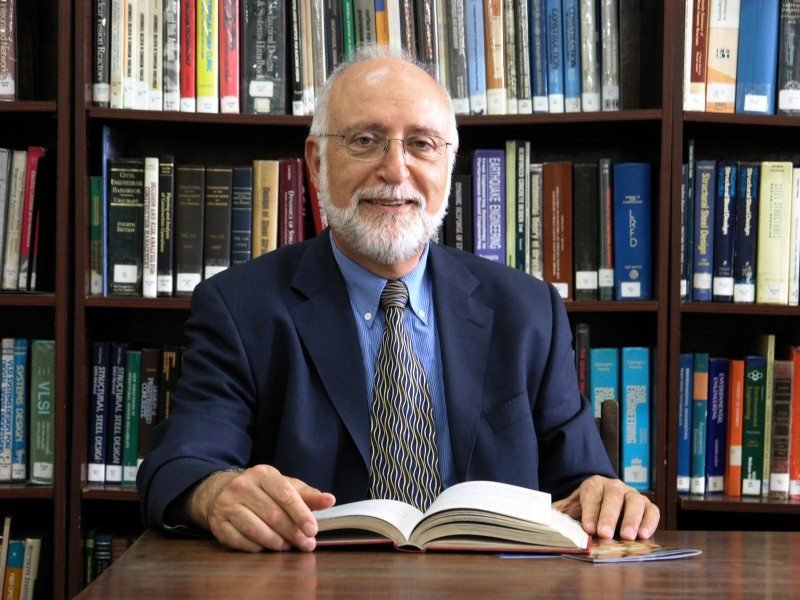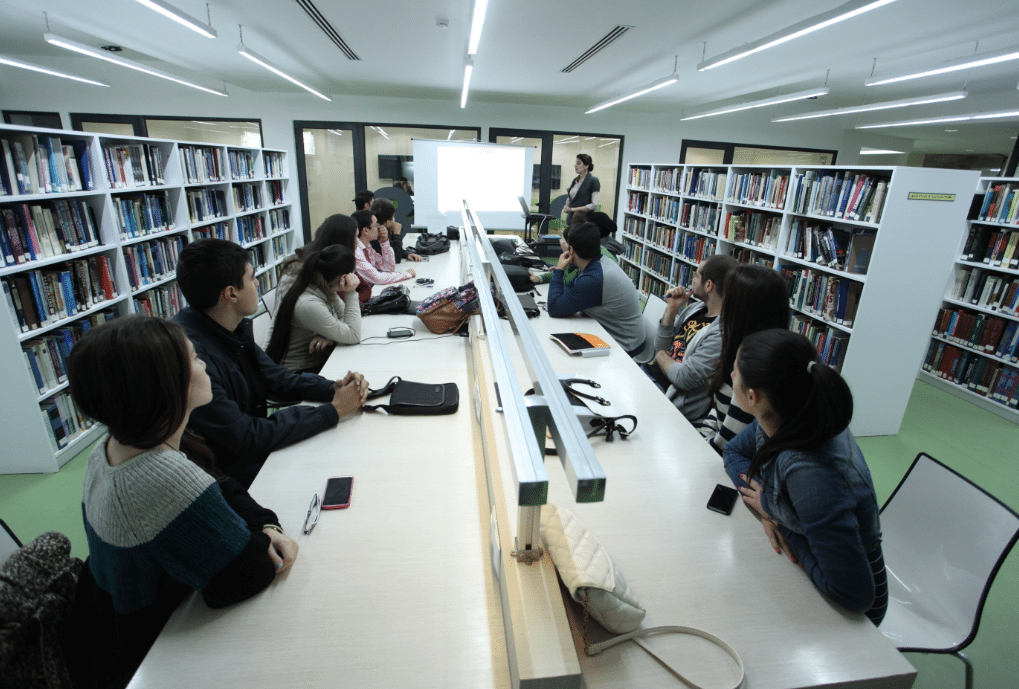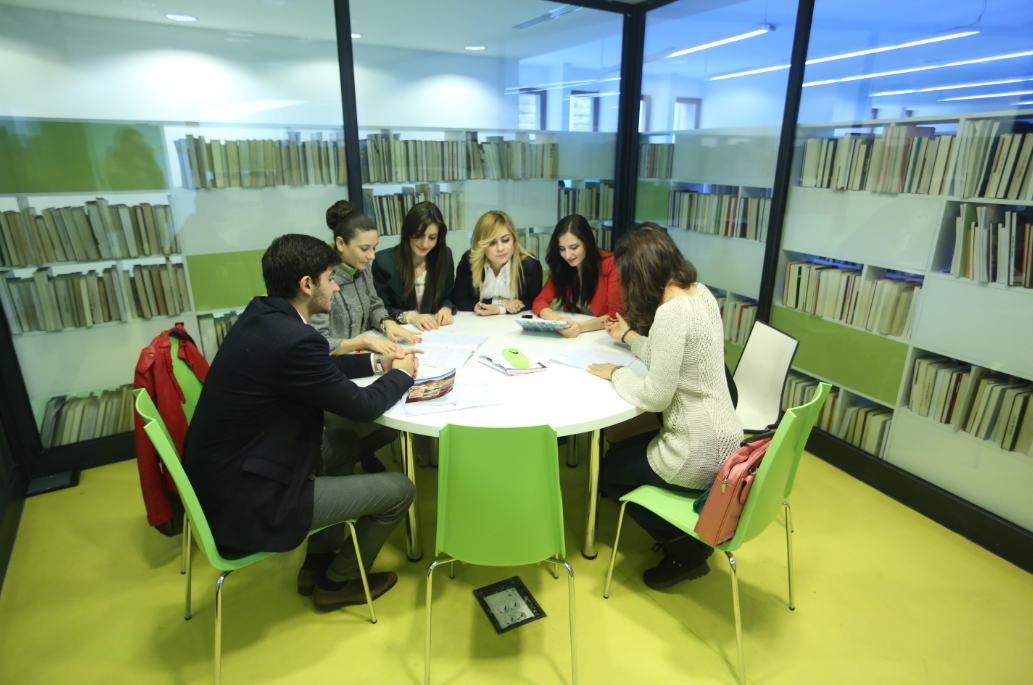An Interview with AUA President Armen Der Kiureghian
The American University of Armenia (AUA) is considered one of the top academic institutions in Armenia. What many do not know, however, is that the university was established in the wake of tragedy and disaster. Founded in 1991, the university was a constructive response to the great losses—both human and economic—incurred during the devastating earthquake of 1988.

The earthquake had brought out a number of engineers from North America to help reconstruct the areas shattered by the natural disaster. It was at that time that Yuri Sarkisian, then rector of the Yerevan Polytechnic Institute, reached out to Armen Der Kiureghian, then Professor of Civil Engineering at the University of California, Berkeley, with the idea of establishing an American-style technical university in Armenia—a great idea for a country quickly moving towards independence.
Fast forward 27 years, and Dr. Der Kiureghian is now the president of AUA, an institution that has been serving students and academics from Armenia and abroad for the past 24 years. Der Kiureghian, who had served as interim president of the university since the departure of President Bruce Boghosian in July 2014, accepted the permanent position earlier this year.
Der Kiureghian has been one of AUA’s most active and dedicated supporters since the university’s inception. He is the founding dean of AUA’s College of Science and Engineering, served as interim provost, and has been an AUA trustee from day one.
Today, nearly a quarter century since its founding, Yerevan’s AUA continues to be the only U.S. accredited university in the former Soviet Union territory and the only university in the region offering an American education. Two years ago, AUA began offering bachelor’s degree programs for the first time, which allowed for the university to open its doors to an entirely new group of students.
Most recently, AUA initiated a program created to meet the growing needs of Armenia’s Syrian-Armenian community. As the situation in Syria continues to decline, the program helps provide assistance for Syrian-Armenian refugees who have fled their country to resettle in Armenia.
The Armenian Weekly recently spoke to Der Kiureghian to get a better understanding of some of the challenges the university faces and how he plans to lead the institution to new heights.
***
Rupen Janbazian: You have served as visiting professor at universities in Slovenia, Japan, Italy, Denmark, India, and Germany. In what ways have your experiences abroad informed your work at AUA?
Armen Der Kiureghian: Every university is different. And wherever I have visited, I have learned new ways of doing things and gained more experience. Of course, the University of California [UC], Berkeley, where I have spent 37 years of my professional life, is where my academic roots are. UC Berkeley is a superb university and many of my initiatives at AUA are modeled after what I have seen there. Nevertheless, my experiences at other universities in the United States, Europe, Japan, and India also guide my work at AUA.
R.J.: What have been some of the challenges you’ve faced since taking over as president?
A.D.K: There have been challenges, but also many rewarding experiences. The biggest challenge was the recruitment of a new provost. Dr. Donald Fuller, our interim provost, served with distinction, but he had promised to serve for one year only. Fortunately, we were successful in recruiting Dr. Randall Rhodes, who was the associate provost at Frostburg State University in Maryland. He is already on board and is performing his duties as the chief academic officer of the university.
There has also been the challenge of managing a university that has costs similar to Western universities, but tuition income that is far below. The cost of education at AUA is heavily subsidized. In addition, about 45 percent of our students receive discounts ranging from 25-90 percent of the tuition. We are grateful to our many donors who have set up scholarship endowments that help us ensure that no applicant who is good enough to be admitted will be unable to attend due to financial constraints.

There have also been numerous rewarding experiences. Just seeing our students’ bright faces every day, seeing them studying in the library and classrooms, watching them interact freely with their professors and advisers, make my day. Of course, the culmination was the graduation event on June 6, when we added another 250 graduates to our alumni base. The excitement and the feeling of accomplishment among the graduates as well as the faculty and administration were simply overwhelming.
R.J.: The AUA recently began offering bachelor’s degree programs for the first time. How successful have the programs been since their launch?
A.D.K: We began the bachelor’s program in 2013 with almost 300 students in three majors: business administration, computational sciences, and English and communications. This fall, we will have over 1,000 undergraduates. The number of applications we receive each year is significantly increasing, both among domestic and international students. Compared to 2012-13, the number of domestic applicants has doubled and the number of applicants from outside of Armenia has tripled. This indicates that word is spreading about the quality of education that we provide.
We can measure the success of the program in other ways as well. For instance, we have a Center for Student Success, the first of its kind in Armenia, that provides advising, workshops, disabilities services, and much more to AUA’s undergraduates. Students really see it as a home away from home. And in just two years, they’ve managed to create 12 student clubs and conduct Student Council elections. Our students take initiative, explore their interests, participate in self-governance, and really get involved in campus activities and life.
R.J.: How does the AUA reach out to diasporan communities to attract prospective students?
A.D.K: AUA welcomes students from all over the world, Armenian and otherwise. We have made a number of visits to diasporan communities, including Rostov, Moscow, Boston, Brussels, and other cities. This past year, our director of admissions, Arina Zohrabian, went on a 2,000-mile recruitment tour across California to encourage young students to pursue their higher education at AUA, either as degree students or for the study abroad program. She spoke at universities, high schools, and community centers across the state about the many opportunities that AUA has to offer. This fall, she will be making a trip to the East Coast of the United States. Our development team, based in Oakland, Calif., represents AUA at several events and functions across the country where prospective students are in attendance. We are also making a special effort to recruit non-Armenian students from other countries, including China, India, and Iran.

There are a lot of reasons to study at AUA: we’re affiliated with the University of California, which means it’s easy to transfer your credits; we’re accredited by the WASC Senior College and University Commission, meaning students have the assurance that they are receiving a quality education; we have state-of-the-art facilities and classrooms; and much more. This past year was especially eventful for us, as we established two critical relationships with the University of California, Los Angeles [UCLA] and the University of California, Irvine [UCI]. We now offer an AUA-UCLA Summer Intensive Program in Armenian Studies, and have signed a Memorandum of Understanding with UCI with the aim of promoting future educational and scientific cooperation between the two universities. This type of collaboration enables the exchange of ideas, values, and experiences, connecting students and faculty in Armenia with those on the other side of the world.
R.J.: What percentage of the students are repatriates? Are there any programs to help better integrate students from outside of Armenia?
A.D.K: Historically, the percentage of students at AUA who are not citizens of the Republic of Armenia has varied between 9 and 10.5 percent. Some of the countries that students most commonly come from are Syria, Russia, Iran, and the U.S., but during the last five years, AUA has hosted students from 24 different countries.
Integration happens very easily and naturally at AUA. The inclusiveness and acceptance that our students show toward one another reflects the Western-style education that they are receiving. Our Center for Student Success plays a big role in this, as it is the chief organizer of cultural events such as International Education Week, International Women’s Day, and National Youth HIV & AIDS Awareness Day, which have become yearly traditions at AUA. By being exposed to global cultures, practices, and issues, our students have a greater understanding and tolerance of others.

For many of our students, whether they are from Armenia or elsewhere, the university becomes their home away from home. Some of them even like to hang out at AUA on weekends!
Having this eclectic student body means a diverse set of interests. Joining one of our student clubs is a great way for those who are not from Armenia to make friends, explore different pastimes, and get involved in campus activities and student life. For Syrian Armenians who come to study at AUA, there is a growing community, which provides a sense of comfort and home. There are also many scholarships available to Syrian-Armenian students, both in the degree programs and for Extension courses. Eighteen among our 46 Syrian-Armenian students have gone through the Extension program before being admitted.
R.J.: As the situation in Syria continues to decline, the AUA has initiated a program that provides assistance to Syrian-Armenian refugees who have fled their country. Please discuss the program. How was it conceived? How many Syrian-Armenian students are benefitting from it? What are some of the challenges?
A.D.K: The program was created to meet the growing needs of Armenia’s Syrian-Armenian community. Through our Extension program, and thanks to the many generous donors, we’ve been able to provide free classes to hundreds of Syrian Armenians who come to AUA looking to improve their English, take preparatory courses, or gain professional and work skills. By offering these classes for free, AUA is able to provide some stability to these students at a time of uncertainty in their lives. Many of these Syrian-Armenian students have gone on to enroll full-time at AUA, or have started their own businesses in Armenia. Overall, I can say that this program has been very successful. However, a lot more can be done if more funds become available.
R.J: AUA’s admission policy is need-blind. Nearly half of your students receive some sort of financial support. Where does this support come from? How is it funded?
A.D.K: As I mentioned earlier, nearly 45 percent of our students (more than 600 in number) receive some amount of tuition-assistance scholarship. A portion of this is provided by our donors, either as annual contributions or as scholarship endowments. The donors and the scholarship recipients are acknowledged each year in our graduation booklet as well as the annual report of the university. However, we provide a lot more tuition assistance than the donated funds, and this comes from our general funds that are also critically important for operational expenses. With our increasing number of students, we are very much in need of additional scholarship donations.
R.J: AUA is the only university in Armenia that has developed policies for organizing the educational process for students with disabilities. Why was this important for the university?
A.D.K: AUA has made a special effort since day one to make the university accessible and accommodating to those with disabilities. Indeed, a requirement by our WASC Senior College and University Commission accreditation is accessibility for people with disabilities. Last year, an OSCE [Organization for Security and Cooperation in Europe] funded survey conducted by Unison NGO found that, among 29 higher education institutions across Armenia, AUA was the only one to have a wheelchair-accessible campus and to have developed policies for organizing the educational process for students with disabilities. USAID’s American Schools and Hospitals Abroad program, which has funded some of the renovations we have made, has applauded our efforts to make the university accessible to people with disabilities.
We have retrofitted our Soviet-era Main Building with a ramp to the entrance, provided reserved parking for handicapped persons, and renovated restrooms with handicapped-adjusted cabins with railings. Our state-of-the-art Paramaz Avedisian Building is fully designed to meet the needs of people with physical disabilities. It’s equipped with large elevators, restrooms in the west and east wings, and a ramp.

AUA has also taken care to provide services to those with mental or learning disabilities through the Center for Student Success. Students who wish to have the university management know about their disability fill out a form that describes their specific challenges, and submit it to the Center for Student Success. The center coordinates meetings between the student, their teachers and a counselor, resulting in an individualized approach to education that also ensures confidentiality. Issues of disability are often incorporated into the curriculum and discussed in the classroom so students and faculty are socially aware and accepting of those with special circumstances. So far, AUA is the only university in Armenia considering these issues and implementing changes. Our aim is to go beyond educating students; it is to provide an alternative model of teaching and learning that can be emulated.
R.J: As Armenians receiving an American education, what can your alumni bring to the country? What kind of perspectives does an AUA education grant them? What percentage of them stay in Armenia?
A.D.K: Our master’s degree students spend two years and our bachelor’s degree students spend four years of their lives at our university. This is a merit-based environment devoid of corruption, where critical thinking, self-expression, openness, and personal responsibility are taught and encouraged. Our graduates absorb these values and then take them into the Armenian society, into their workplaces, their families, and their broader communities. Through this process, they contribute to the economic and social development of Armenia.
Some people have expressed concern that by providing an American education we make it easy for graduates to leave Armenia. In actuality, more than 70 percent of our alumni live in Armenia. This is a larger percentage than the percent of the general population that has remained in Armenia after independence. Our graduates tend to have better paying jobs, and have fewer reasons to leave the country. After establishing our undergraduate program, we often hear from parents that if the option of studying at AUA were not available, they would send their children abroad for a Western education. Hence, by providing a Western education right here in Armenia, we are preventing these aspiring students from leaving the country at such a young age. At the same time, we attract many Diasporan Armenians, some of whom end up living and working in Armenia after their graduation. Finally, AUA is becoming a hub for Armenian scholars who have gone abroad, received doctoral degrees, and now want to return and work in an academic position. We are one of the very few places where such individuals can build meaningful academic careers.
R.J.: What are some of the future plans for the institution?
A.D.K: We have many plans, many dreams. Twenty years ago, we started with 100 students in three degree programs. We only had our main building, much of it empty. This fall, we will start with almost 1,600 students in eight graduate and three undergraduate degree programs. In addition to our main building, we have the 10,000-square-meter Paramaz Avedisian Building, which has state-of-the-art classrooms, conference rooms, an auditorium and the Akian Gallery. Next year, with 2000 students, we will be at our physical capacity for both buildings. So, the historical trend is that we will grow. But the pace may be slower than in recent years. Establishment of every new program requires approval by the board. Three main considerations are the need in Armenia for the field of study; job prospects in Armenia for the graduates; and sustainable funding for the program. At present, a few new programs are being considered. Among them, hospitality and tourism management has good prospects. We are also hoping to expand our physical facilities. We have plans to build a student union and a faculty center, both of which are novelties in Armenia, adjacent to the Paramaz Avedisian Building. We also hope to expand the campus buildings in order to provide more classrooms and laboratory facilities to accommodate new programs and increased enrollment.
Presently, we are in the process of modernizing our student services facilities and building a state-of-the-art Innovation & Technology Incubation Center (ITIC). The ITIC will coalesce existing activities in entrepreneurship and innovation at AUA in a synergistic location, where student teamwork, creativity, and innovative technologies can come together to foster new ventures and partnerships.


It is wonderful to have AUA in Yerevan with its modern and innovative programs. And accolades should be given to all administrative personnel, especially its President Dr. Armen Der Kieureghlian for their extensive effort to make the AUA a big and a unique SUCCESS! Kudos to you all.
Do they have courses in Medicine?